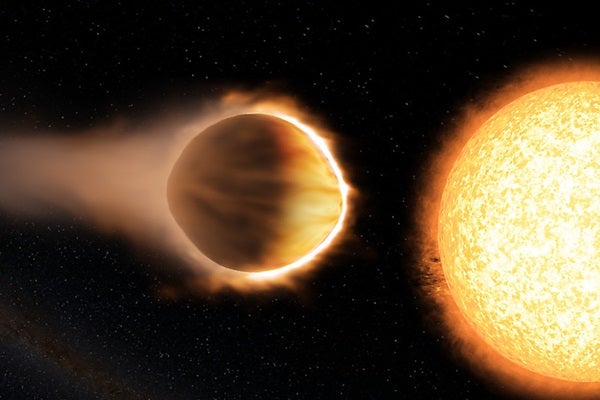First, it’s useful to define “counterclockwise” for an orbit or object in space, since we see exoplanets and their stars from all angles! For a rotating body, we define “up” along its axis of rotation, such that it rotates counterclockwise when viewed right-way-up. For planetary orbits, we set “up” perpendicular to the plane of the orbit, so that when viewed right-way-up, the planet travels counterclockwise around its star.
Hot Jupiters are giant planets close to their parent stars, with orbital periods of one to 10 days. These planets could not have formed in place — there is not enough material that close to a star in a protoplanetary disk to create such a massive planet. Instead, astronomers think hot Jupiters form at roughly the distance of present-day Jupiter and Saturn from the Sun. They then migrate inward over millions of years to reach the close-in orbits we see today.
One unresolved question is how this migration occurs. There are two possible scenarios. First, hot Jupiters can migrate inward due to drag from the protoplanetary disk material that remains after they form. A planet affected by this kind of “disk migration” would have a present-day orbit closely aligned with the orientation of the protoplanetary disk. Second, hot Jupiters can move inward via “scattering migration,” where they gravitationally interact with another nearby giant planet, or with a more distant companion of their host star. In this scenario, hot Jupiters develop highly eccentric, cometlike orbits.
Because of the influence of tides, over hundreds of millions of years such orbits transform into the nearly circular hot Jupiter orbits we see today. Critically, scattering migration is chaotic and would randomize the orbital orientations of hot Jupiters, so they would rarely align with the old protoplanetary disk.
Because those disks were cleared out several billion years ago, we instead use the parent star’s rotation to determine how the planets migrated inward. Conservation of angular momentum forces protoplanetary material into a disk extending away from the equator of the parent star, aligning it with the star’s rotation.
Astronomers can measure the spin-orbit angle between a hot Jupiter’s orbital orientation and the rotation axis of its parent star. By convention we define “up” to lie along the stellar rotation axis. A spin-orbit angle near 0° means the planet’s orbit is closely aligned with the star’s rotation (and traveling counterclockwise), while a spin-orbit angle of 180° means the planet is orbiting opposite the star’s rotation (and traveling clockwise).
So finally, what are the numbers? We have 74 hot Jupiters with measured spin-orbit angles, as of this writing. Of those, 49 planets, or 66 percent, have spin-orbit angles less than 30° and are orbiting counterclockwise. The other 25 planets are nearly evenly spread out from 30° to 180°, with two orbiting almost opposite the direction of their star’s rotation.
This means that while most hot Jupiters (66 percent) migrate inward via disk migration, one-third of the hot Jupiters we see were thrown inward by some sort of scattering process.
Thomas Beatty
Assistant Research Professor,
Department of Astronomy & Astrophysics,
Penn State, University Park, Pennsylvania










